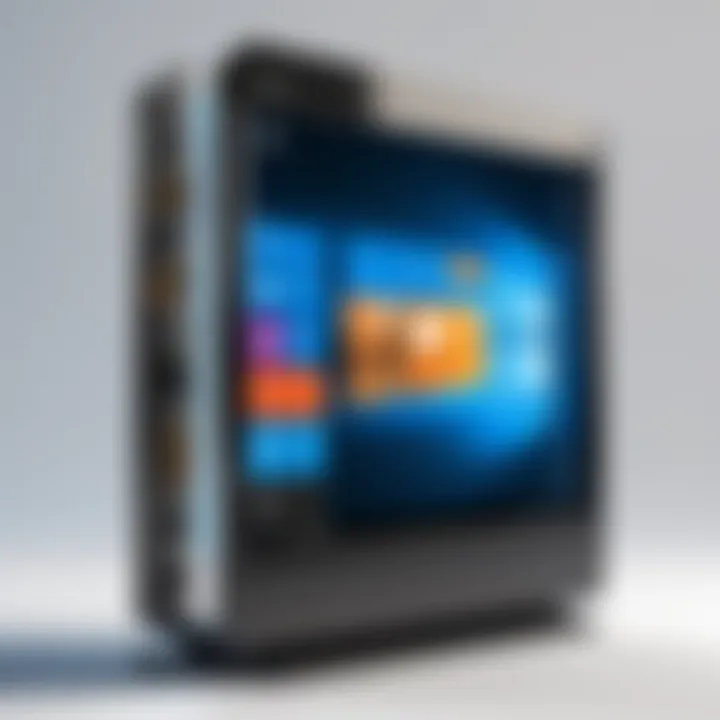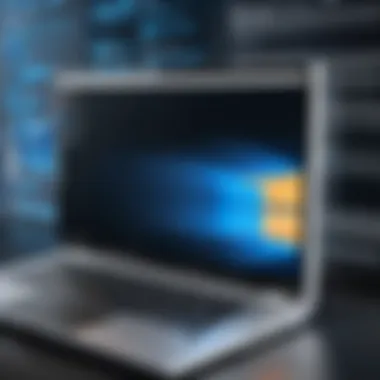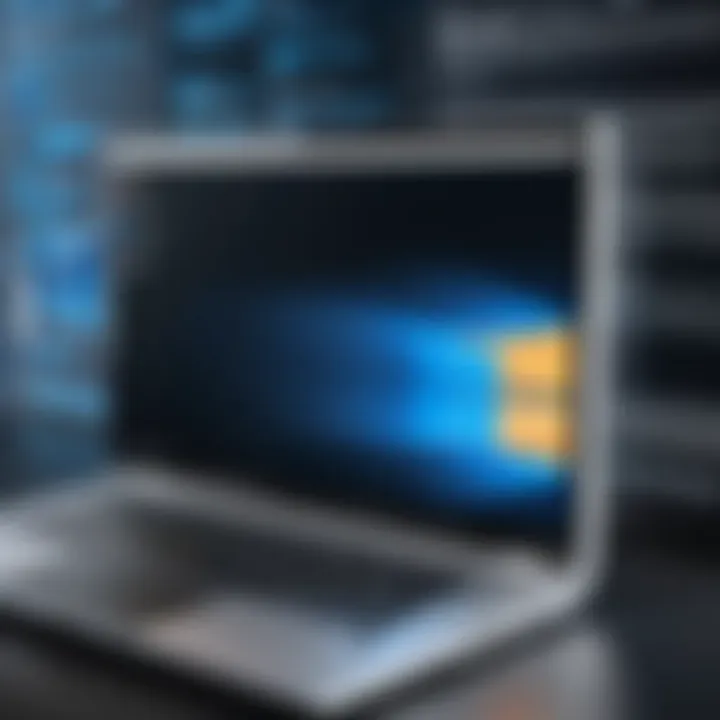Boost Your Windows 10 Performance: Overcoming Sluggishness


Intro
Windows 10 has become a widely used operating system among many users, ranging from casual computer owners to dedicated technology enthusiasts. While its features offer significant advantages, many individuals encounter performance issues that lead to frustrating experiences. This article will dissect the common factors that cause a Windows 10 computer to run slowly. By understanding these challenges, readers can improve the efficiency and responsiveness of their devices.
Slow performance in Windows 10 may stem from multiple sources, including hardware limitations, software conflicts, and misconfigured system settings. These issues can manifest in various ways, such as sluggish application launches, frequent system crashes, or longer boot times. Through a methodical examination of each contributing factor, we aim to provide actionable insights, so that users can activate solutions to counteract and optimize their systems effectively.
As we progress through the article, we will delve into key areas impacting performance, providing technical insights and maintenance tips. The objective is to equip both tech-savvy individuals and everyday users with the knowledge they need to address these performance challenges and restore their devices to optimal functioning.
The complexity of Windows 10's system architecture requires a comprehensive understanding of both hardware and software interactions. Therefore, the forthcoming sections will offer a clear framework to help demystify the underlying issues.
"Optimizing a computer's performance requires both understanding and action. Knowing the causes is half the battle."
Let us now examine the technology behind Windows 10, exploring its specifications and unique features that may influence performance.
Foreword to Windows Performance Issues
Addressing performance issues in Windows 10 is a crucial topic for many users, whether they are seasoned tech enthusiasts or everyday computer users. The efficiency of a computer directly impacts productivity, creativity, and overall user satisfaction. As technology continues to evolve, understanding performance becomes even more essential. A sluggish system can frustrate users, disrupt workflow, and lead to missed deadlines. In this article, we will explore the various challenges that lead to slow Windows 10 computers, identifying root causes and effective solutions.
Understanding the Importance of Performance
Performance in Windows 10 is not an abstract concept; it has real-world implications. When a computer operates efficiently, users experience faster responses, smoother multitasking, and less downtime. This efficiency translates to better productivity and a more enjoyable computing experience. The significance of performance is underscored by the increasing reliance on technology for both personal and professional tasks. A well-performing system enhances the user experience, allowing users to focus on their tasks.
Common User Experiences with Slow Computers
Users commonly report several frustrating symptoms when dealing with slow computers. These experiences often include:
- Lagging applications: Programs take longer to respond, leading to interruptions in workflow.
- Long startup times: Computers may take excessive time to boot up, delaying access to essential functions.
- Frequent freezing: The system can become unresponsive at critical moments, disrupting tasks.
- Inefficient multitasking: Running multiple applications simultaneously may strain system resources, causing slowdowns.
Recognizing these common experiences is the first step in addressing the underlying issues. Each user's frustration presents an opportunity to delve deeper into diagnosing the specific causes of their slow Windows 10 system. Understanding these challenges can guide them toward effective strategies for improvement.
Identifying Root Causes of Slow Performance
Understanding the root causes of slow performance in Windows 10 is essential for users seeking to enhance their computing experience. By identifying specific issues, one can implement targeted solutions that efficiently resolve performance bottlenecks. This section will explore the critical factors that lead to sluggishness, including hardware limitations, software conflicts, and improper system settings. A thorough assessment of these causes can make the difference between a seamlessly functioning device and one that frustrates the user.
Hardware Limitations
Hardware limitations often serve as the fundamental cause behind an unresponsive or slow Windows 10 computer. Each component within a computer plays a vital role in delivering optimal performance. Focusing on hardware can highlight potential upgrades or adjustments that may enhance the system’s speed and capability.
Processor Speed and Capability
The processor acts as the brain of the computer. It executes instructions and processes data. A slower processor speed can significantly hinder performance, especially when running demanding applications. Modern processors, like Intel Core i7 or AMD Ryzen 7, are designed for superior multitasking. A key characteristic is their ability to handle multiple threads, allowing for better performance during intensive tasks. Not upgrading to a processor with a higher speed and capability limits a system’s overall efficiency. However, a more powerful processor often comes with a higher price tag and might also require an upgraded motherboard.
Insufficient RAM
Random Access Memory (RAM) plays a critical role in how efficiently a computer operates. Insufficient RAM can lead to excessive paging to the hard drive, creating slowdowns. As applications become more resource-intensive, the need for RAM increases. A computer with 8GB of RAM may struggle with multiple applications, whereas systems with 16GB or more can perform better under load. The key aspect of RAM is its ability to provide quick access to data that needs to be processed. However, upgrading RAM does not address other bottlenecks in the system, such as an old processor or hard drive.
Hard Drive Type and Health
The type and health of the hard drive can heavily influence performance. Solid State Drives (SSDs) offer much faster data access and transfer speeds compared to traditional Hard Disk Drives (HDDs). The lag experienced with an HDD can be considerable during start-up and when launching programs. An SSD minimizes boot time and application loading time. However, SSDs can be more expensive per gigabyte than HDDs. Additionally, a failing drive, irrespective of type, can drastically affect performance. Regular health checks of the hard drive can provide insights into potential issues before they escalate.
Software Conflicts
Software conflicts can arise from various sources, and they contribute significantly to performance-related problems. Identifying these conflicts is vital in maintaining a fast and efficient system. Users can resolve these issues through updates, configuration changes, or uninstalling incompatible software.
Outdated Drivers
Drivers are essential software components that allow the operating system to communicate with hardware devices. Outdated drivers tend to be poorly optimized, leading to increased CPU usage and potential crashes. Keeping drivers updated is crucial for maximizing component efficiency. Programs like Driver Booster can identify outdated drivers, making it easier for users to manage their system. The drawback is that updates occasionally introduce new compatibility issues.
Resource-Intensive Applications


Certain applications consume significant system resources. Programs such as Adobe Photoshop and AutoCAD can slow down performance, especially on lower-spec machines. Identifying these applications allows users to manage or limit their usage. A common strategy is to use alternatives or cloud-based solutions. However, some resource-intensive software may be necessary for work, making it challenging to balance performance with functionality.
Incompatible Software Programs
Incompatible software can lead to significant performance issues. For instance, running software designed for an earlier version of Windows can cause instability and slow responsiveness. Regularly checking for compatibility and applying updates is essential. Uninstalling or replacing such software may be a necessary step. The downside is that users might lose access to features or tools they rely on, requiring a period of adjustment.
System Settings and Configuration
System settings play a critical role in influencing a Windows 10 computer's speed and responsiveness. Proper configuration ensures optimal use of resources, while poor settings can lead to sluggish performance.
Background Processes
Background processes can consume valuable system resources, leaving less for active tasks. Windows 10 has many services running in the background, some of which may not be necessary. Using Task Manager, users can monitor and disable non-essential processes. However, stopping certain processes without understanding their function may affect system stability.
Startup Programs
Many programs automatically launch during startup, causing delays. Managing these startup applications can result in a quicker boot time. Users can configure startup settings in Task Manager, allowing only essential applications to run at start-up. While this helps improve boot speed, it may require users to manually launch certain applications later on.
Power Settings
Windows 10 includes different power settings that can affect performance. The balance between performance and energy savings is crucial. Switching to a high-performance plan can enhance responsiveness but may lead to increased power consumption and heat, impacting battery life in laptops. Users must weigh their needs against potential disadvantages.
Assessing System Performance
Assessing system performance is a critical step in understanding why a Windows 10 computer struggles with speed. Performance assessment helps identify not just the evident symptoms, like lag or slow boot times, but also the underlying issues that may not be immediately visible. By using systematic approaches, users can gather valuable insights into hardware health, software behavior, and system configuration, all of which play significant roles in overall performance. This process allows for targeted interventions, optimizing the user experience. Finally, it contributes to informed decision-making regarding upgrades or adjustments needed for improvement.
Using Windows Built-in Tools
Task Manager Analysis
Task Manager is a built-in utility that provides a real-time overview of active processes and their resource consumption. Its simplicity and immediate availability make it a popular choice for diagnosing performance issues. By offering a snapshot of CPU, memory, disk, and network usage, Task Manager enables users to identify any hogging resources that may slow down their computer. One unique feature of Task Manager is its ability to display performance metrics in real time, which can be instrumental in pinpointing problems during specific tasks or applications.
While Task Manager is effective for quick assessments, it does have limitations. It may not provide the in-depth analysis needed for serious performance issues but serves as an excellent first step in diagnostics.
Windows Performance Monitor
The Windows Performance Monitor is a more advanced tool that allows users to track system performance over time using detailed metrics. This tool is advantageous for those seeking a deeper understanding of performance trends and patterns. One notable characteristic is its ability to create customized data collectors, allowing users to gather specific metrics relevant to their situation. This feature can lead to more targeted troubleshooting approaches.
However, its complexity can be a disadvantage for less experienced users. Nevertheless, despite the learning curve, it is a powerful resource for users wanting to conduct thorough performance assessments.
Third-Party Diagnostic Tools
System Optimization Software
System optimization software offers solutions to enhance computer performance through a variety of methods, such as cleaning up unnecessary files, managing startup items, and tuning system settings. These tools are beneficial because they often provide a user-friendly interface that makes optimization accessible to all users. One distinctive feature of many optimization programs is their ability to automate routine maintenance tasks, saving users time and effort.
However, users need to exercise caution, as not all software is created equal. Some optimization tools may attempt to alter settings without sufficient user insight, potentially causing more harm than good. Therefore, it's essential to choose reputable software backed by good reviews and a strong track record.
Benchmarking Applications
Benchmarking applications evaluate the performance of computer components using various tests to measure speed, efficiency, and performance under load. These tools offer critical insights into how well the hardware performs against standard benchmarks, which can highlight areas needing attention. A key characteristic of benchmarking applications is their ability to provide objective data, making it easier to identify performance gaps.
Although benchmarking provides valuable information, it can be resource-intensive and might temporarily affect system performance during tests. Additionally, results can vary depending on testing conditions, so users should interpret them thoughtfully.
Assessing system performance through these various tools equips users with the knowledge necessary to make informed decisions about optimizing their Windows 10 experience.
Solutions to Enhance Performance
Enhancing the performance of a sluggish Windows 10 computer is essential not only for user satisfaction but also for overall productivity. Many users face challenges due to efficiencies in their machines. Thus, addressing these issues is paramount. The solutions range from hardware upgrades to software optimization and adjusting system settings. By adopting these strategies, users can significantly improve their computing experience, making their machines run faster and more effectively.
Hardware Upgrades


Upgrading hardware components in a computer can offer noticeable improvements in performance. Here are key areas to focus on:
Installing More RAM
Adding more RAM can lead to faster multitasking and improved system responsiveness. Many users find that their systems slow down when handling multiple applications due to limited memory capacity. Increasing RAM allows for more processes to be run simultaneously without lag. It is a beneficial move for users who regularly run resource-heavy applications like graphic design software or games. The unique feature of RAM upgrades is their ability to transform a machine’s capability without needing a full hardware replacement. The main disadvantage can be cost, but the performance gains often justify the expense.
Switching to an SSD
Replacing a traditional hard drive with a Solid State Drive (SSD) can yield tremendous speed improvements. SSDs are significantly faster than HDDs, providing quicker data access times. This leads to shorter boot times and faster file transfers. Consumers often choose SSDs for their reliability and performance. The key characteristic is that they have no moving parts, which reduces mechanical failures common in older drives. The downside may be the higher cost per gigabyte, which might discourage some users from making the switch.
Upgrading the CPU
Upgrading the CPU can give an older computer a new lease on life. A more powerful processor enhances computation speed, allowing applications that require significant processing power to run effortlessly. This method is often considered a more advanced upgrade since compatibility with the motherboard must be taken into account. The unique feature of CPU upgrades is their potential for performance leaps in tasks such as video rendering or gaming, where CPU performance is crucial. The main disadvantage is the need for technical skill to install, as well as possible increased heat output requiring better cooling solutions.
Software Optimization Strategies
To address software-related performance issues, consider the following strategies:
Disabling Unnecessary Startup Items
Preventing unnecessary programs from starting at boot can significantly speed up the startup process. Windows has many applications that load by default, which consume important resources. Disabling these can lead to faster initial system responsiveness, benefiting by leaving more memory available for the tasks that matter. The key characteristic is that users can tailor their system’s startup to suit their needs. However, it requires users to make informed choices about what can be safely disabled.
Uninstalling Unused Programs
Removing applications that are no longer in use can free up system resources. Many users accumulate software they do not actively use, which takes up valuable hard drive space and can slow a system down. Uninstalling such programs can not only reduce clutter but also lead to more efficient operation. It is a popular choice because it requires minimal effort while offering noticeable improvements. The downside is that users may uninstall something they need later, leading to inconvenience, but careful review can help mitigate this risk.
Regular System Updates
Keeping the operating system updated is a vital practice for system performance. Updates often include performance enhancements, bug fixes, and security patches that contribute to smoother operation. The key benefit is improved stability and speed, which spurs overall efficiency. Moreover, running the latest version of Windows ensures that users benefit from new features. The disadvantage could be the need for additional reboots and temporary disruptions, but the long-term gains far outweigh these drawbacks.
Adjusting System Settings
Fine-tuning certain settings can enhance performance further. Here are some adjustments worth considering:
Customizing Visual Effects
Reducing or disabling visual effects can free up system resources. Windows is known for its visually appealing interface, but these graphics can be taxing for lower-end hardware. By customizing these effects, users can focus more system resources on performance-intensive tasks. The unique aspect combines aesthetics with functionality, offering a performance boost in exchange for some visual fidelity. The only downside is the potential loss of visual appeal, which some users may prefer to keep intact.
Power Management Adjustments
Optimizing power settings can also improve performance. Users can adjust their power plans to emphasize performance over energy saving. This will utilize the full capacity of the system when plugged in, boosting performance during resource-intensive tasks. This feature is particularly beneficial for laptops that might otherwise limit processor speed to conserve battery life. However, users should be aware of potential impacts on energy consumption and battery longevity.
Managing Background Applications
Controlling background applications can free resources and boost performance. Many applications run in the background without user knowledge. Monitoring these processes and shutting down unnecessary ones can lead to improved system performance. The key benefit is a smoother experience during workflows. Although some users may close vital applications accidentally, careful management can prevent this.
Regularly enhancing system performance can lead to an overall better computing experience. By implementing various hardware and software strategies, users can address performance challenges effectively.
Regular Maintenance for Long-term Performance
Regular maintenance is crucial for sustaining the performance of a Windows 10 computer over time. As software and user demands evolve, even a well-functioning machine can start to slow down. This section emphasizes the importance of systematic upkeep, which helps ensure that the device remains efficient and responsive to user needs. Without proper maintenance, users risk encountering continuous performance issues that can lead to a frustrating experience.
Routine Disk Cleanup
Utilizing Disk Cleanup Tool
The Disk Cleanup Tool is a valuable built-in utility in Windows 10 that assists users in reclaiming disk space. This free software tool simplifies the process of locating and removing unnecessary files, such as temporary files and system files. The primary benefit of the Disk Cleanup Tool lies in its ability to swiftly free up space without requiring complex navigation through the file system.
By performing regular cleanups, users often notice improved performance and quicker access times. The Disk Cleanup Tool uniquely includes options for cleaning up system files, which can significantly improve storage efficiency. However, it may not be able to remove all unnecessary files, so combining this tool with other methods is typically advisable for optimal performance.
Managing Temporary Files


Managing temporary files is an essential aspect of maintaining system performance. Temporary files can build up over time from internet browsing, application usage, and from system updates. By regularly managing these files, users can prevent clutter that leads to disk space shortages.
The noteworthy feature of this maintenance task is its ability to enhance system speed and efficiency. One of the most significant advantages of removing temporary files is improved loading times for applications and faster overall system responsiveness. However, users must be cautious during this process, as removing important files can inadvertently disrupt workflow or application functionality.
Defragmentation and Optimization
Understanding Disk Fragmentation
Disk fragmentation occurs over time as files are written and deleted from disk space, leading to disperse file storage. Over time, this fragmentation can slow down file retrieval, as the system struggles to piece together files stored in various physical locations on the hard drive. Understanding fragmentation is critical for users aiming to optimize their systems.
Being aware of how fragmentation affects performance can motivate users to take necessary actions to maintain their system's efficiency. Users can benefit from better read and write speeds, especially on traditional spinning drives (HDDs). Yet, it is less of a concern for Solid State Drives (SSDs), as they function differently.
Using Built-in Defragmentation Tool
Windows 10 comes with a built-in defragmentation tool that automates the process of consolidating fragmented files. It runs on a schedule and can be manually activated if desired. This automation is a key feature that contributes to maintaining optimal performance without the need for constant user intervention.
Users find this tool beneficial as it simplifies the complex process of file management. While the built-in defragmentation tool can enhance HDD performance dramatically, it's important to note that SSDs do not require defragmentation, and attempting to do so might reduce their lifespan. Thus, users should assess their hardware type before utilizing this utility.
Future Trends in Windows Performance Optimization
The realm of Windows performance is continually evolving, shaped by technological advancements and user demands. Understanding future trends in Windows performance optimization is critical for both tech enthusiasts and everyday users. This section will delve into upcoming features and the integration of artificial intelligence, which promise to transform how users optimize and manage their devices. The focus is not only on innovation but also on practical applications that can enhance everyday computing experiences.
Upcoming Windows Features
Microsoft is known for its commitment to enhancing user experience with each iteration of Windows. Anticipated features focus on improved speed and efficiency. Key developments include advancements in system resource management and enhanced user interface tailoring.
Some noteworthy improvements are expected:
- Virtual Desktop Enhancements: Expect more intuitive management of multiple desktops, allowing users to organize their workflows efficiently.
- Improved File Explorer: New features will likely include quick access options for frequently used folders and better search functionality, significantly reducing time spent navigating file systems.
- Enhanced Update Management: The aim is to minimize downtime with smarter scheduling during off-hours, ensuring updates do not interrupt critical tasks.
These features aim to create a more responsive and user-centric operating environment. The goal is to make routine tasks seamless and to optimize resource allocation on devices with varied specifications, enhancing overall system performance.
Artificial Intelligence in Performance Management
Artificial intelligence is set to revolutionize how performance management is approached in Windows 10. By utilizing AI, Microsoft can analyze user behavior and optimize system settings accordingly. The benefits include automated adjustments to resource allocation, which can significantly enhance performance without user intervention.
Key aspects to consider include:
- Dynamic Resource Allocation: AI can learn from user patterns and adjust CPU and memory resources dynamically, leading to smoother multitasking experiences.
- Predictive Maintenance: Leveraging AI for predictive analytics may help identify potential issues before they affect system performance. This proactive approach can reduce downtime, allowing users to maintain efficiency.
- Personalized User Experience: Customized settings based on usage patterns can result in a more tailored experience, addressing individual workflow preferences and needs.
"AI is transforming how performance management is approached, making systems smarter and more efficient."
The incorporation of artificial intelligence in Windows performance optimization represents a significant shift. It is not only about enhancing speeds but also about creating systems that adapt to users’ needs. This evolution in technology aims to minimize frustration and improve overall satisfaction with Windows 10.
Closure
One of the central elements in this section is the recap of vital points regarding performance enhancement. It is crucial for readers to remember the various hardware and software issues affecting their systems. By revisiting these factors, users can better assess their computers and take necessary actions. Furthermore, the understanding of proper maintenance techniques will ensure users can achieve long-term performance improvements.
From the hardware upgrades to software optimization techniques, the conclusion underscores that effective management of a Windows 10 computer does not stop after initial improvements. Instead, regular checks, updates, and a keen awareness of potential performance inhibitors are essential. By adopting a proactive management approach, users can significantly extend the lifespan and efficiency of their devices, thus maximizing the value of their investments.
Recap of Key Points
In this article, we covered several essential aspects to improve a slow Windows 10 computer:
- Identifying Root Causes: Understanding hardware limitations, software conflicts, and system settings that can hinder performance.
- Assessing System Performance: Learning how to utilize Windows built-in tools and third-party diagnostic tools for accurate analysis.
- Solutions to Enhance Performance: Discovering practical hardware upgrades, software optimizations, and adjustments to system settings that restore speed.
- Regular Maintenance: Emphasizing routine disk cleanup and optimization practices to sustain performance benefits over time.
- Future Trends: Considering upcoming features and advancements in artificial intelligence that may simplify performance management in the coming years.
This recap not only highlights the significant topics but also serves as a reminder that maintaining an optimal system requires a multi-faceted approach that combines awareness, responsive actions, and continuous evaluation.
Encouraging Proactive Management
Encouraging proactive management unveils the core philosophy behind achieving and maintaining optimal computer performance. Users must adopt a mindset that prioritizes not just reactive solutions but anticipatory actions aimed at preventing performance decay.
To foster this proactive approach, users can:
- Regularly Monitor System Performance: By keeping an eye on CPU usage, memory consumption, and disk health, users can identify issues before they escalate.
- Schedule Routine Maintenance: Set reminders for tasks such as disk cleanup, software updates, and antivirus scans. Making these activities habitual can greatly reduce the chances of facing major slowdowns.
- Stay Informed on New Tools and Technologies: As Windows evolves, new features and tools will emerge that can enhance performance. Keeping abreast of these developments can help users leverage the best available solutions.
- Engage in Online Communities: Platforms like Reddit and various tech forums can provide valuable insights on troubleshooting and optimizing performance from other users' experiences.
Being proactive in these facets will not only yield immediate benefits but also foster a deeper understanding of one's system, ultimately leading to a more satisfying computing experience. Adopting such practices ensures users are better equipped to tackle potential challenges, thus transforming the way they interact with their Windows 10 computers.







